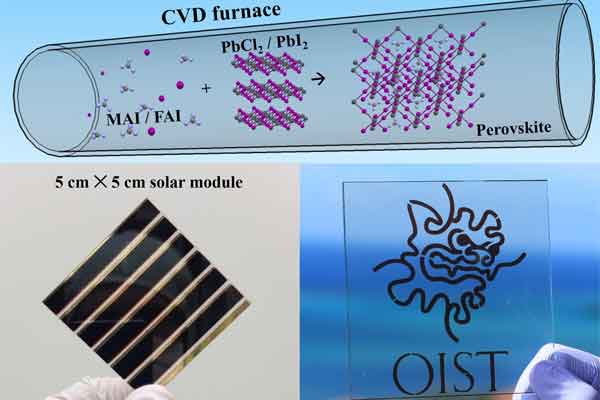With the high environmental cost of conventional energy sources and the finite supply of fossil fuels, the importance of renewable energy sources has become much more apparent in recent years. However, efficiently harnessing solar energy for human use has been a difficult task.
While silicon-based solar cells can be used to capture sunlight energy, they are costly to produce on an industrial scale. Research from the Energy Materials and Surface Sciences Unit at the Okinawa Institute of Science and Technology Graduate University (OIST), led by Prof. Yabing Qi, has focused on using organo-metal halide perovskite films in solar cells.
These perovskite films are highly crystalline materials that can be formed by a large number of different chemical combinations and can be deposited at low cost. Recent publications from Prof. Qi’s lab cover three different areas of innovation in perovskite film research: a novel post annealing treatment to increase perovskite efficiency and stability, a discovery of the decomposition products of a specific perovskite, and a new means of producing perovskites that maintains solar efficiency when scaled up.

Top photo depicts how perovskite films are made using the chemical vapor deposition (CVD) technique. Bottom left shows a perovskite solar module produced using the CVD technique. Bottom right displays the OIST logo made from perovskite using the same technique. Credit: Image courtesy of Okinawa Institute of Science and Technology Graduate University – OIST
In order to be useful as solar cells, perovskite films must be able to harvest solar energy at a high efficiency that is cost-effective, be relatively easy to manufacture, and be able to withstand the outdoor environment over a long period of time.
Dr. Yan Jiang in Prof. Qi’s lab has recently published research in Materials Horizons that may help increase the solar efficiency of the organo-metal halide perovskite MAPbI3. He discovered that the use of a methylamine solution during post-annealing led to a decrease in problems associated with grain boundaries.
Grain boundaries manifest as gaps between crystalline domains and can lead to unwanted charge recombination. This is a common occurrence in perovskite films and can reduce their efficiency, making the improvement of grain boundary issues essential to maintain high device performance. Dr. Jiang’s novel post annealing treatment produced solar cells that had fused grain boundaries, reduced charge recombination, and displayed an outstanding conversion efficiency of 18.4%. His treated perovskite films also exhibited exceptional stability and reproducibility, making his method useful for industrial production of solar cells.
One of the biggest disadvantages to the use of perovskites when compared to silicon in solar cells is their relatively short lifespan. In order to create a solar cell that can withstand the outdoor environment over a long period of time, it is crucial to determine the major products of perovskite decomposition. Previous research on MAPbI3 perovskite films led to the conclusion that the gas products of thermal degradation of this material were methylamine (CH3NH2) and hydrogen iodide (HI).
However, exciting new research from Dr. Emilio J. Juarez-Perez, also in Prof. Qi’s lab, published in Energy & Environmental Science, shows that major gas products of degradation are methyliodide (CH3I) and ammonia (NH3) instead. Dr. Juarez-Perez used a combination of thermal gravimetric differential thermal analysis (TG-DTA) and mass spectrometry (MS) to correctly determine both the mass loss and chemical nature of these products. Because the products of decomposition have now been correctly identified, researchers can look for ways to prevent degradation of the material, leading to more stable materials for use in the future.
A pervasive problem in academic research is often the inability to scale up experiments for use in industry. While perovskite films can be made with relative ease on a small scale in the laboratory, they can be difficult to replicate on the large scale needed for mass production.
New research from Dr. Matthew Leyden in the Journal of Materials Chemistry A has the potential to make industrial production of perovskites much easier. His work uses chemical vapor deposition, a cost-effective process commonly used in industry, to create large solar cells and modules of FAPbI3 perovskites.
This is one of the first demonstrations of perovskite solar cells and modules fabricated by a method widely employed in industry, making the mass production of perovskite films more feasible. The solar cells and modules produced are significantly larger, e.g., 12 cm2, than those commonly studied in academia, typically
These solar modules show enhanced thermal stability and relatively high efficiencies, which is impressive as many perovskite solar cells lose efficiency drastically as they are scaled up, making this type of research useful for commercial purposes.
Research from Prof. Qi’s research unit has brought perovskite solar cells one step closer to mass production by providing solutions to problems of efficiency, life-span, and scalability. With more exciting research on the horizon, the unit is bringing the dream of utilizing cost-effective renewable energy resources into reality.
Reference(s):
Publication: Emilio J. Juarez-Perez, Zafer Hawash, Sonia R. Raga, Luis K. Ono, Yabing Qi. Thermal degradation of CH3NH3PbI3perovskite into NH3and CH3I gases observed by coupled thermogravimetry–mass spectrometry analysis. Energy Environ. Sci., 2016
Research story: Okinawa Institute of Science and Technology Graduate University – OIST | October 5, 2016 (source)















Comments